Little Bighorn Battlefield National Monument memorializes a major battle fought on June 25, 1876, between Lakota, Cheyenne and Arapaho Indians against the United States Army. These tribes were fighting to preserve their traditional way of life as nomadic buffalo hunters. The U. S. Army was carrying out the Grant Administrations instructions to remove the Lakota Sioux and Cheyenne Indians to the great Sioux Reservation in Dakota Territory.
I really can't explain the feeling of standing at the different places on the battlefield and being able to "see" how everything transpired. Oh well, I will try to give you an idea of what our day was like.
Little Bighorn National Monument
Of course, we started off at the museum and watched a 17 minute film...the who, what, when, where, why and how of the battle.
We decided to do the bus tour first to get a good overview. Our guide was from Little Bighorn College and is a decendent of "Curly", a Crow scout for the US Government.
He did a great job...with a little humor thrown in!
In 1874, Lt. Col. George Custer led an expedition into the heart of Indian lands and discovered gold in the Black Hills. Soon thousands of fortune seekers and settlers invaded the region. To protect their land and lifestyle, Native Americans began to resist the intruders. Under sitting Bull, Crazy Horse, and Gall, Sioux and Cheyenne tribes united for mutual support in 1875.
In December, 1875, the United States Indian Commissioner ordered these tribes back to their reservations. Any Indians refusing to go back would be forced to return by the Army.
Custer's command departing Fort Lincoln in May 1876, is a part of the Army's campaign. His regiment soon joins briefly with Col. John Gibbon and 450 soldiers with the Montana Column. The two columns are under overall command of Brigadier General Alfred H. Terry.
The Indians under sitting Bull are gathering somewhere in southeastern Montana.
The Terry-Custer force pushing westward is one of three Army columns numbering approximately 2,500 men in search of the Indians who are gathering in ever increasing numbers under Sitting Bull's leadership. Another contingent, nearly 1,000 soldiers, commanded by Brigadier General George Crook, marches northward from Fort Fetterman. The plan...the three Army columns will trap the Indians between them and their escape will be impossible.
By mid-June, Terry and Gibbon meet along Yellowstone River, between the Tongue and Powder Rivers. About 100 miles to the southwest, however, Crook is surprised by a powerful Indian attack led by Crazy Horse and Two Moons. After the Battle of the Rosebud on June 17, Crook is forced to retreat back to his base camp on Goose Creek. Unaware of Crook's fate, Terry and Gibbon continue their pursuit.
Soon Army scouts, most of them Crow and Arihara Indians who are enemy of the Sioux and Cheyenne tribes, discover a fresh path the "hostile" tribes have left. The trail leads toward a river the Indians call Greasy Grass. The soldiers call it the Little Bighorn.
On June 21, Terry, Gibbon and Custer plan their attack. The next day they put their plan in motion. Custer's order were to approach the Indians from the south. Terry and the rest of his force, accompanied by Gibbon's column, moves west along the bank of the Yellowstone to the mouth of the Bighorn River. They will advance on the Indians from the north.
Meanwhile, increasing numbers of Native Americans leave their reservations and join the Indian camp. They are willing to fight to defend their homeland and preserve their way of life.
Their camp on the Little Bighorn grows to about 1,000 lodges, home to almost 10,000 Indians including 1,200 to 2,000 warriers.
By early morning, June 25, 1876, Custer and his soldiers are poised on a bluff overlooking the river. From near this perch, Custer's Crow and Arihara scouts view traces of smoke and a vast pony herd, indicating a large Indian camp about 15 miles ahead. Soon he received word that his soldiers have been spotted by the Indians. Fearing the element of surprise is lost and that the Indians will escape, Custer reacts immediately, rather than wait for Brigadier General Terry and Colonel Gibbon regiments to arrive the next day.
Custer divides his command. Just after noon, Capt. Frederick Benteen leads 125 men on a sweep of high ground several miles to the southwest. About 2:30, Major Marcus Reno and 140 troopers separate from Custer and cross the Little Bighorn River to attack the Indian camp from the south.
Around 3:00, Major Reno launches his assault...but Indian resistance is fierce and, within minutes, Reno is forced to retreat. Finally, without support from Custer, Reno's soldiers flee in confusion to the top of the bluff.
Very few Indians died in the Battle of Little Bighorn. Brick colored markers are placed where they died. White markers are placed where solders died.
Again, Custer divides his command. Three companies under Captain Miles Keogh move along the crest of the ridge.
Two companies commanded by Captain George Yates descend a ravine (Medicine Tail Coulee) toward the Little Bighorn. Warriers guarding the ford battle Yates at the river's edge. Great numbers of Indian braves led by Gall surge over the river. Dismounted soldiers fire from ragged skirmish lines trying to slow the tide of warriors. The troopers efforts are in vain.
Down river more Indians mass under Crazy Horse, who leads them across the Little Bighorn and, in overwhelming strength, assail Custer from all directions. Military formations collapse. Solders cluster together in isolated pockets and, under a hail of bullets and arrows, Custer and his men are killed. This would beome known as Custer's Last Stand.
That night, June 25, 1876, around bonfires throughout their village, Indian tribes celebrate their great victory. Benteen's men have reunited with Reno's survivors. The soldiers wonder what had become of Custer.
On the afternoon of June 26, the Indians depart the battleground when Terry and Gibbon approach to rescue Reno and Benteen.
One of the intriguing aspects of the Battle of the Little Bighorn is what happened to two of Custer's companies whose remains were found in and along the trail leading to Deep Ravine. Historians have pondered their fate ever since. Some claim they were attempting to drive the Indians off the lower ridges; others declare they were trying to signal their position to the Reno and Benteen's battalions; still others maintain they were attempting to escape the awful fate that awaited them. No one knows.
I'm really glad to have experienced this. It was a very thought provoking day. There are many "versions" of the Battle of Little Bighorn...mine is just another one based on what I "think I learned"!

















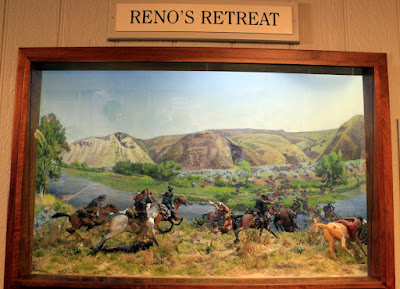







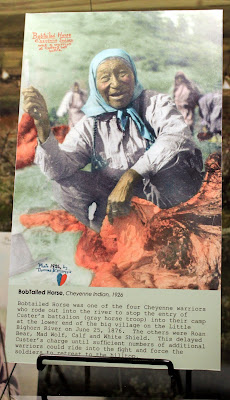


















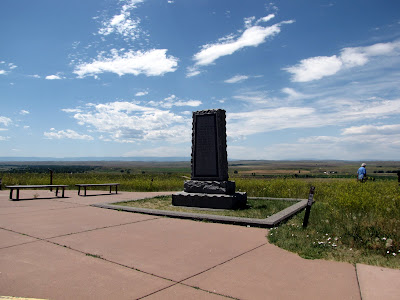



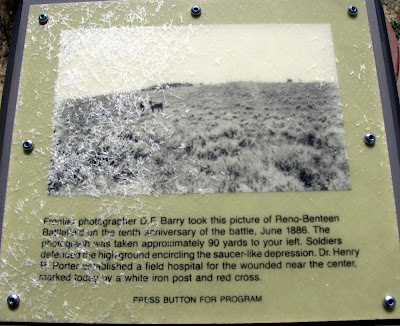

















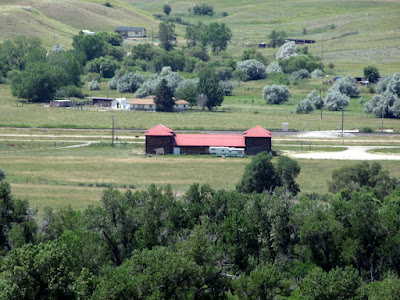






































































No comments:
Post a Comment